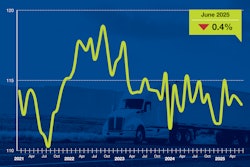Freight shipment volumes dwindled in July, while expenditures slightly increased, largely driven by shrinking demand and tariff impacts, according to a Cass Freight Index for Shipments report.
Shipments fell to 1.8% from June and were down 6.99% from a year ago, marked as the largest year-over-year decline since January.
“Tariffs hit shipments harder in the most recent data, as paybacks began from demand pull-forwards earlier in the year, though good prices are still relatively steady,” said Tim Denoyer, the report’s author and ACT Research vice president and senior analyst.
Expenditures, which track total amount spent on freight, fell 1.5% from June and were slightly up 0.4% from a year ago. It rose for the fourth consecutive month in July, after more than two years of annual declines. The year-over-year gain was driven by higher rates, as shipments fell 6.9% in July.
“We infer rates rose 7.9% year-over-year, largely due to changing modal mix, similar to the past several months, with more truckloads and lower LTL mix,” the report said.
Freight volumes are hitting one of the slowdowns that ACT Research has been anticipating, with further dips likely after a temporary lift in Q3, Denoyer said.
At the same time, tariffs are also driving up vehicle prices, and heavy truck makers are reducing production, he said, adding that in the second half of 2025, North American Class 8 production is expected to drop more than 25% compared to the first half.
“As the economy is likely to absorb the effects of tariffs over the next several months, our freight demand outlook remains cautious,” Denoyer said.
The potential upside of reduced vehicle production and manufacturing job losses should tighten capacity, he said, as it could likely drive freight back to the for-hire market next year.
Meanwhile, economic activity in the manufacturing sector deteriorated further in July, contracting for the fifth consecutive month, following a two-month expansion that was preceded by 26 straight months of contraction, according to the Manufacturing ISM Report on Business. The May PMI registered at 48.0 (a reading of 50 or higher signals growth), down 1.0% from June’s 49.0.
The U.S. manufacturing activity in July contracted at a faster rate, with declines in the supplier deliveries and employment indexes driving the one-percentage point loss, said Susan Spence, chair of the ISM Manufacturing Business Survey Committee. Demand indicators such as new orders and backlog orders contracted at slower rates, while the customers’ inventories and new export orders contracted at slightly faster rates, according to the report.
New orders continued to slow amid tariff uncertainty, Spence said, as which party will pay tariff costs is still the prime issue in negotiations between buyers and sellers.
“Tariffs are causing complete uncertainty around sourcing strategies. A sit-and-wait game for now,” said a survey respondent in the electrical equipment, appliances and components sector.
Another respondent from the transportation equipment sector said, “Cautiously stable. Tariff impacts are still being monitored. Some increases have been implemented while monitoring other products.”
S&P Global U.S. Manufacturing PMI index also echoed similar sentiments, recorded 49.8 in July, down from June’s 52.9. It followed six successive months of growth, representing the first overall deterioration of operating conditions in 2025, according to the report.
“The downturn at the start of the third quarter in part reflects the passing of a busy period of tariff-related inventory accumulation in prior months,” said Chris Williamson, chief business economist at S&P Global Market Intelligence.
Weakness in the index reflected softness in market demand, with new orders up only slightly and to the weakest degree of the year so far, according to the report. Panelists also pointed to the continuation of client uncertainty in tariffs policy, resulting in ongoing tentativeness to new orders, especially amongst international clients.











